
Telephones of the Swing Era
A survey of classic phones...

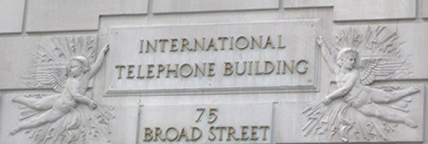
Cherubs and Lighning Bolts
International Telephone Building, NYC
Click to Enlarge
This is a very brief article that barely scratches the surface of Telephone History. We have covered the basic phones that would be of interest to retro-swing lifestyle. Each type of phone has hundreds of variations. Just in case you have a special request, here are some navigational tools
- Frequently Asked Questions with Very Quick and Free Answers
- Candlestick Phone
- Desk Sets of the 1920s
- Integrated Phones - The Fabulous 300s
- The '50s and the 500 Series
- Coin Operated Phones
- Phone Booths
- Other Interesting Phones
- Where can I get my phone fixed?
In addition to Phones, we have a Calendar of Swing Dancing in DC, a Directory of Vintage Clothing Stores and a Guide to 1940s Collectibles. Thanks for tuning in! Feel free to Contact Me if you have questions or want to share photographs and/or "Get on the Line" with the rest of the readers.
- Q. How can I find out what the "old" phone number was in my location?
(at one time, numbers had an "exchange" in them, like WOodley 9- 9999)
A.You should visit the Telephone Exchange Names Project - Q. How can I get an authentic looking Number Card to go on the dial of my phone?
A. You should visit This Site to make a new dial card to go with your authentic phone number. - Q. How do I get the cover off the Number Card Holder?
A. Visit This Site or This Site or This Site. - Q. Do you sell anything?
A. We don't sell anything. Everything here is free to everyone. - Q. Are you Phone Experts?
A. Nope. We are interested in blending phones into retro decor. It also helps if you understand a little bit about the technology and history, so we provide our interpretation. The real experts are at the Telephone Archive. - Q. You seem to like a repair service called "The Phone Vault." Do you get anything from them for mentioning their business?
A. Not a thing. We had five phones repaired there, the last one in 2005. Their service was cheap, speedy and of high quality.
CANDLESTICK PHONES
These are the earliest telephone instruments that could be part of a retro-swing lifestyle. They are known as candlestick phones because (duh!) they look like a candlestick. If you are reading this in 2050, you may not know what a telephone or candle is, but even in 2009 these were common household appliances. The former was a device for communication, much like the little chip you have implanted in your head. The latter was a source of illumination based on the combustion of waxy hydrocarbons. At the very mention of combustion, the Carbon Police may come busting through the doors, but back in the old days this was quite an acceptable means of lighting... The Candlestick phone was standard issue by the Bell System from 1900 to the mid 1920s. Since the Bell system only replaced phones when someone moved or died, some of them continued in service into the 1950s.
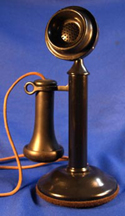
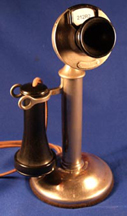
Non-Dial "Candlestick" Phones
Left: Black, WE Type 20 Right: WE Nickel, Type 20AL
Click to Enlarge
In the old days,you took the receiver off its hook and an Operator asked you Number Please (pronounced "num-bah plee-uz") and then placed your call for you. Here is a little video explaing how this worked. Back in the old days, there was no line current, so you had to crank a magneto (a kind of electrical generator) to make enough current to ring the bell at the central operator's switchboard.
This practice vanished in the big cities by the 1940s when the system became so big that it was impossible to find a sufficient number of nasal, rude operators and Bell had to rely on automation. In small places, like Washington, Pennsylvania (about 50 miles south of Pittsburgh), operator assisted systems persisted into the mid 1950s. My Grandfather's number was "3975J".
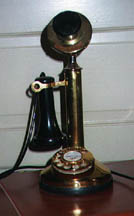
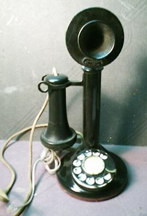
"Candlestick" Phone
Left: 1970s Reproduction Right: Authentic 1925 Phone
Click to Enlarge
The phone on the left is ours. Alas, it is a reproduction of a Western Electric Model brass candlestick phone. The original (Model RE) dates from about 1925. The earpiece is hard rubber. There is a little engraved plate on the mouthpiece that advises you to "Hold Close to Mouth." At one time, the candlestick phone was the norm, but it didn't have a dial. Before we go any further, please look at this little training film that was produced in 1927 to orient customers to the high tech world of dialing:
However, you'll note that our unit has a dial and the phone that it was copied from (in Korea) was part of the transition between the older operator-linked systems and the modern automated telephone system. Dial candlesticks, real or reproduction, are currently desirable because with very little modification, you can make it work right alongside the most modern devices, and forget that all the excresences of modern society have not yet appeared. There are no Toots or Tweets with this phone.
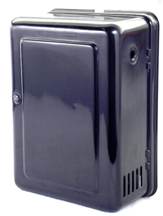
The Ringer Box
The brass bells inside made a distinctive "ringtone"
Click to Enlarge
The reproduction has circuitry and a ringer inside the base. The real version requires a separate "ringer box" to hold the non-miniaturized components like the bells.
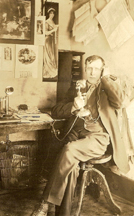
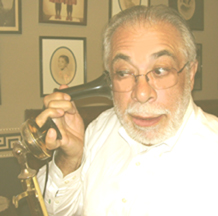
Two - and One-Handed Use of the Candlestick Phone
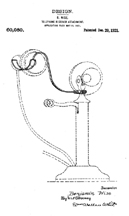
Holder for Candlestick Phone's Earpiece
Design patent D-60,080
Click to Enlarge
Click Here to find out how to ger FREE Patent Drawings
You may see this model in the movies! In the film The Maltese Falcon, Sam Spade (Humphrey Bogart) learns of the death of his partner Miles Archer (Jerome Cowan) on a Model RE. Spade turns the phone to the camera and you can clearly see the little plate that says "Hold Close to Mouth"
In The Sting, Robert Redford demonstrates a "one hand hold" as he hooks the mouthpiece between two fingers and holds the earpiece with thumb and forefinger. This tricky maneuver would be obviated by the device in Patent D-60,080. However, the "one hand approach" could lead to problems because shifting carbon granules in the microphone could lead to either static or volume reduction. The fact that the phone had to "sit still" for best reception led to a lot of research to improve "mobility", which we will see in the next section on Desk Sets.
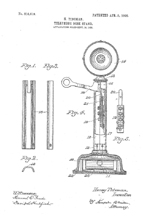
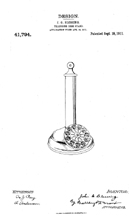
Western Electric Candlestick Phones
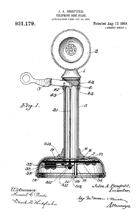
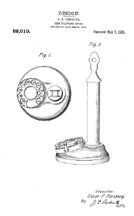
Automatic Electric Candlestick Phones

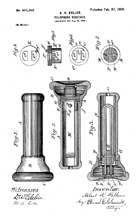
Transmitter (Mouthpiece) and Receiver Were Patented Separately
Western Electric Type 20 Candlestick Phone, Patent No 816,619
Western Electric Type 51AL Dial Candlestick Phone, Patent D-41,794
Automatic Electric Candlestick Phone, Patent No 931,179
Automatic Electric Dial Candlestick Phone, Patent D-52,010
Early Telephone Transmitter, Patent No 1,087,718
Early Telephone Receiver, Patent 644,308
Both Transmitter and Receiver were often switched out by the company as improvements were made
Click to Enlarge
Click Here to find out how to ger FREE Patent Drawings
Be very careful if you see one of these phones at a yard sale or flea market -- they were widely copied during the 1970s and 1980s due to the popularity of the film The Sting.
- For a Reproduction, about $25 is a reasonable price
- For a Real candlestick, be prepared to pay $300 and up.
Thie webpage will help you tell the difference between an authentic Candlestick and a reproduction:
Click here to look at another type of collectible, or keep on scrolling for more telephones.
DESK SETS OF THE 1920s
These were the first widely distributed telephone sets to feature the transmitter and receiver in a common handset. As you've seen above, prior sets ("candlestick") had the transmitter fixed to the base, and the receiver held to the ear. The phones did not contain bells or other circuitry and required a separate (and large) Ringer Box. The box would be mounted somewhere out of the way, and the sets that you see below would be placed near to where they were to be used, hence the name "desk set".
This was made possible by solving two major technical problems:
- First, the transmitters of the day did not work well unless oriented in a vertical plane. If moved to other angles, as would be expected in a single handset, carbon granules in the transmitter would move around, resulting in poor voice quality, referred to as "carbon noise".
- Second, audio from the receiver, known as sidetone, could be picked up by the transmitter and amplified, resulting in a squealing noise fed back through the receiver (acoustic feedback). (You have heard this at rock concerts...)This problem was made worse by the signal boosting circuitry used in the subset which resulted in a much stronger signal at the receiver, as well as the hollow handsets which provided an internal channel for the audio to reach the transmitter.
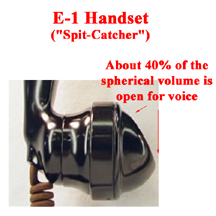

E-1 Anti-Feedback Microphone
Patent No. 1,687,211 and Patent 1,797,891
(A.K.A. "The Spit-Catcher")
Click to Enlarge
Click Here to find out how to ger FREE Patent Drawings
In the 1920s, developments in anti-feedback circuitry and mobile "non-positional" microphones led Western Electric to move forward with developing a handset model ("E1") that would be free of both of these problems. A variety of devices were used to reduce sidetone including the characteristic mouthpiece that enclosed the microphone, leaving about 90 degrees of spherical surface open in order to shield outside noice from voice. For this reason, it is known as a "spit catcher".
The Western Electric 102
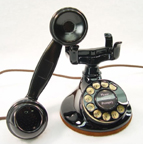

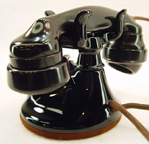
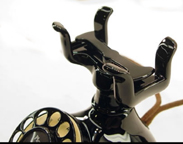

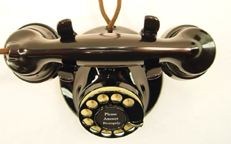
Western Electric Model 102
Model E1 Handset Patent No. 1,687,211
Model 102 Stand Patent D-65,204
Click to Enlarge
Click Here to find out how to ger FREE Patent Drawings


WE 102 as the Symbol of Service
...service in the Animal Husbandry sense
Click to Enlarge
This phone was a prototype from 1922-1926 and was used within the Bell System offices. These prototypes were eventually designated "A-1" and fitted out with dials from candlestick phones as shown above. The prototype phones -- with A1 stamped on the neck -- are quite rare and valuable.
In 1925-1926 the phone was re-designed to use its own dial, and these examples are marked "B-1". As you'll note above, the set (or "mount") was independent of its handset (or integrated transmitter/receiver) The phone in the pictures is a "B Handset Mount" (or just "B1"). Note that the dial sits above the base. These sets were distributed to the public between 1927 and 1930.If you look closely, you can see a non-dial version of the B1 with a wood magneto ringer box near the front door of the bus stop in the Marilyn Monroe film Bus Stop. It's about halfway through this trailer, in the part where Arthur O'Connell is introduced as "Virgil" -- but don't blink.
The Western Electric 202


The WE 202 Telephone
Remember: Elliptical Base, Inset Dial



Design Exploration for Western Electric 202 Series
Design Patents D- 80,670, D- 80,671, and D- 80,672
Blount was asked to investigate the use of molded Bakelite for the handset mount
We do not believe that any of these were manufactured
Click to Enlarge
Click Here to find out how to ger FREE Patent Drawings
In 1928, the Bell System issued the Model 202 (or "D1") that looks deceptively like the 102, but has an elliptical base and an inset dial. The 202 is somewhat different structurally than the 102 because of the space required to set the dial into the base. Over the years, there were a large variety of gradual improvements to the base, handset and internal operations, so phones with the same external appearance could be marke "F", "G" or "H".
If you are thinking of buying one of these, you should be very careful. In 1950, the Bell System reissued "D Handset Mountings" as colored desksets like the "Imperial" or in a range of colors depending on the needs and desires of the customer. You should carefully inspect a candidate 202 phone to see if it is the 1950 reissue.
The Western Electric 201 Wall Phone
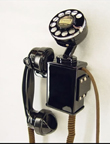
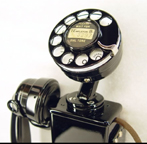
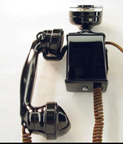
Western Electric Model 201 Wall Phone
The Essence of the 102 Mechanism
Click to Enlarge
At the same time as the 202 sets were introduced, Bell issued a wall set that operated in the same manner as the 102 ("B" Mount) and the 202 ("D" Mount). Not surprisingly, it was named the 201 or "C Handset Mounting." This set was generally hardwired to the ringer box as it too contained nothing more than a hanger (technically a hookswitch) and a dial mounted on a special pedestal. These are exceptionally rare.
The Western Electric Series "E" Phones


Western Electric Series "E" Telephone
More Business Friendly Features
Design Patent D-78,605
Click to Enlarge
Click Here to find out how to ger FREE Patent Drawings
Later models were the "E" series of business desksets complete with buttons for multiple line pickup, hold feature, an intercom circuit, and signaling key. These sets required an equipment cabinet which contained line and hold relays, light relays for illuminating small wall placed light boxes to signal which lines were in use to those working in the vicinity, and an intercom circuit.
Automatic Electric Model 1 Phone


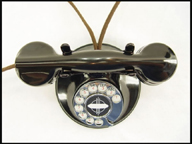
Automatic Electric Model One
Alternate Manufacturer
Click to Enlarge
Automatic Electric (AE) was founded as Strowger Automatic Telephone Exchange Co. by Kansas City resident Almon Strowger, who invented the first automatic (dial) telephone switch in 1889. For decades AE was a leading supplier of telephone equipment to independent (non-Bell) telephone companies across the U.S. The company also at various times supplied switching and other equipment to the Bell System.
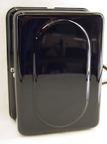
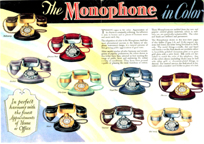

Automatic Electric Model One
Design Patent D - 74,188
Click to Enlarge
Click Here to find out how to ger FREE Patent Drawings
The Automatic Electric Model One bore a very strong resemblance to the WE 102 and 202. Note the AE version of the E-1 Mouthpiece. Unlike the Bell System, Automatic Electric encouraged (rather than allowed) customers to choose colored phones.
Click here to look at another type of collectible, or keep on scrolling for more telephones.
INTEGRATED PHONES
The evolution of the telephone took a giant step forward with the introduction of the "H Handset Mounting" in 1937, best known as as the Model 302. This was the first Bell System deskset to be a complete phone containing in addition to switch, dial, etc., the network and ringer. As we'll see, lots of other manufacturers followed suit, and the "300" series produced some of the most beautiful and classy telephones ever made. HOWEVER, the Bell System was not the first to offer an integrated phone -- that honor belongs to the Automatic Electric company:
Automatic Electric Model 2 Phone
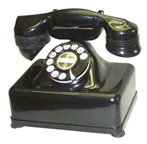

Automatic Electric Model Two
The first integrated phone
Design Patent D- 68,929
Click to Enlarge
Click Here to find out how to ger FREE Patent Drawings
The Automatic Electric Company began selling these phone to the Bell system's competitors as early as 1927. The design is somewhat ungainly because a large "box" was needed to contain all the components that would have gone into the ringer box. These are quite rare.
Click here to look at another type of collectible, or keep on scrolling for more telephones.
The Fabulous Western Electric 300s
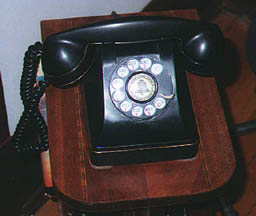
Western Electric Model 302 Telephone
A Real Phone
Click to Enlarge
This is a Western Electric Model 302 telephone. They were in service from 1937 to about 1954. This is the classic phone in the 1940s film noir movies. My partner found this at a yard sale for a dollar.
Our phone has the curly cord which dates it to the early 1950s. Earlier models had a brown cloth cord that often became twisted and tangled; I can remember my dad would untangle the phone cord about once a month after it had become so short that his face was almost in the dial. All of those "seekers after authenticity" out there should take this into account. These sets were generally marked on the bottom or on the back inside edge of the housing with an orange "H" and a number which further designated the modifications to the deskset. The common private line model was the H1 and the party line model was most often marked H3.
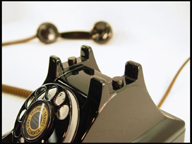

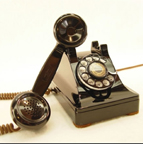

The WE-302 (a.k.a. "H1") was Designed by Henry Dreyfuss

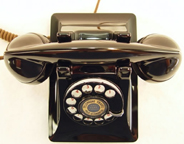

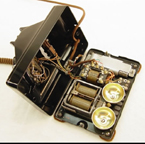
Western Electric Model 302 Telephone
The last photo shows the "innards"
Mount: Design patent D- 95,765, Handset: Design Patent D- 95,915
Click to Enlarge
Click Here to find out how to ger FREE Patent Drawings
Back in the days of the Bell System monopoly, the customer NEVER owned the phone. It was leased for about $4 a month (in perpetuity, a sum that would amout to about $40/mo in 1999 dollars. This phone is incredibly well-built --- it weighs about ten pounds. Here's a little animated video that shows the assembly of a WE-320 phone
The "chassis" is extra-heavy steel and the case and handset are hard rubber, impervious to almost anything. The wiring in the cords is very unusual --- there are strands of live rubber intertwined with the copper conductors, and the whole thing is triple insulated with rubber on the individual wires, rubber around the bundle, a cloth layer and a rubber outer cover. These wires are not going to fray or break! The 300s had a distinctive sound that has never really been duplicated. Here's a sound spectrum analysis of their very distinctive "ring".
If you want to learn more about the Western Electric 300 series, check out Ralph Meyer's Old Time Telephones.
Here is a British film showing how the dials for an integrated phone were made. This model Ericsson phone is the very rough equivalent of the WE500.
The invulnerability of the phone coupled with its relatively low manufacture cost (about $10) generated vast torrents of revenue for the Bell System, since they rarely, if ever, broke down. The phone company took draconian steps to preserve this cash cow. The customer was absolutely prohibited from attaching any other kind of equipment to the system, a regulation that was enforced by a small army of line voltage testers. If you insisted on having something other than a "plain black phone", you had to acquire the thing (at your own cost), then GIVE it to the phone company, then pay a substantial charge for "re-wiring", and then pay the $4 a month lease charge anyway. A popular slogan during the 1940s was "Ma Bell has you by the calls".
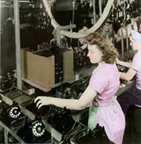

Assembling the Model 300s
A small number of phones were available in color
Click to Enlarge
Under license to the Bell System, several companies would customize the Model 302, mainly by changing the color. White was popular, although we have seen 302's in blue, red, brass, and faux onyx. When you see a scene in a 1940s movie that features a nonstandard phone, you may be certain that the director is sending the message that the character is a person of some wealth and influence, like an executive or a gangster's moll.

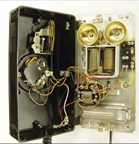

The Model 354 Wall Phone
Click to Enlarge
The "300" series was issued in dizzying variation. Above is the Wall phone (Model 354) that was part of that series.
Click here to look at another type of collectible, or keep on scrolling for more telephones.
Office Phones of the 300 Series
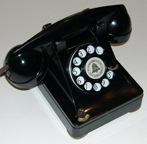
The Model 305 Two Line Phone
Click to Enlarge
We picked up Model 305 (a two line version of the Model 300) just outside Bel Air, Maryland. A small company that sold propane was going out of business and they had thrown the phone away. I scooped it up and it began a two year journey to repair. I fixed the cosmetic damage as best I could and then sent it to The Phone Vault, our favorite phone repair shop. It took them almost two years to find the parts to restore the phone. (It was VERY difficult)! I am thrilled to have the phone on my desk at work and it works just fine!
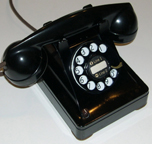
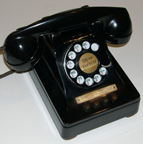

Multi-line Office Phones in the 400 Series
WE 410 two line phone
WE 464 Two Lines, Hold and Intercom
WE 444 Six Line Phone
Click to Enlarge
The multi-line phones were given designations as the 400 series.
Here is a great video that explains automatic long distance dialing in a business setting: "Automation in the telephone industry dispenses with operator long distance dialing to complete calls faster."
This film explains how long distance calls were handled when the first toll dial switching systems were introduced, and contrasts it with earlier methods where the connections were made totally by operators. Part of the explanation about how the new technology worked includes a demonstration with sound of the then new "multi-frequency" or MF tone senders. Different and more pleasant sounding than the "touch-tones" used by our phones today, MF tones were used internally by the switching network. Though they're now nearly extinct, MF tones were considered by phone phreaks to be among the most beautiful sounds heard on the old network.
The film also has some great shots of toll operators processing calls and of the original Western Electric #4 Crossbar switches being built and installed. The climax of the film comes after the old, manual method of calling long distance is compared with the new operator toll dialing when the narrator proclaims: "As soon as the operator presses the proper keys, it happens! Just like that!".
Click here to look at another type of collectible, or keep on scrolling for more telephones.
Kellog "Redbar" Phone
This is the famous Kellogg Model 1000 "Redbar" phone. (It gets its nickname frome the distinctive red bar that serves as the hook flash...)
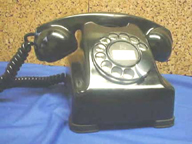
The Kellog Model 1000 "Redbar" Phone
Click to Enlarge
While we are on the subject of Kellogg phones, here is a page from their catalaogue shaowing all the phones they made plus a closeup on a very nifty design for a wall telephone.
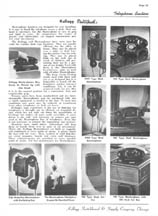

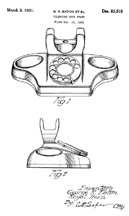
The Kellog Family of Phones
Masterphone Wall Phone Model 9917 Design Patent D-111,592
Masterphone Desk Set Model 925 design patent D-83,515
Click to Enlarge
Click Here to learn how to get free Patent Diagrams
Here are more patents for those nifty Kellogg phones that are shown in the catalogue:
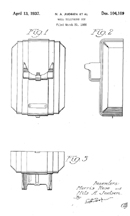
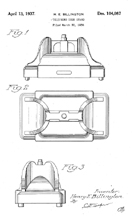
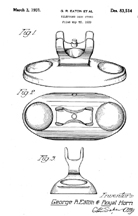

The Kellog Family of Phones
Masterphone Model 9900 Design Patent D-104,109
Masterphone Model 900 Design Patent D- 104,087
Masterphone Model 700 Design Patent D- 83,514
Masterphone Handset Design Patent D-83,599
Click to Enlarge
Click Here to learn how to get free Patent Diagrams
Click here to look at another type of collectible, or keep on scrolling for more telephones.
Automatic Electric Model 40 Monophone
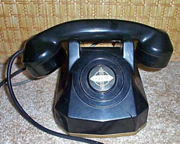

Automatic Electric Model 40 Monophone
Top and Bottom
Clik to Enlarge
We remember that the Automatic Electric Model 2 was the first integrated set to come on the market some 12 years before Western Electric introduced the 300 series. This particular monophone (Model 40) is included here because it is an integrated set and it competes with the WE 300 series on stylistic and technical merits, something that cannot be said of the "clunky" AE Model 2.
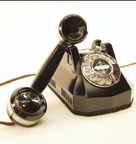
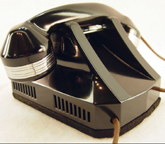
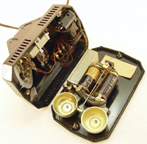
AE Model 40 Monophone
Front, Back and Insides
The design for the Model 40 Monophone was created by Mr. Herbert F. Obergfell of Chicago, Illinois.


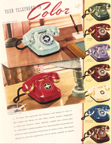
The AE Model 40 Monophone Design Patent - D117,876
We are indebted to Herbert F. Obergfell for This Design
AE used color as a sales incentive
Click to Enlarge
Click Here to find out how to ger FREE Patent Drawings
Click here to look at another type of collectible, or keep on scrolling for more telephones.
Shipboard Variant of the AE Model 40 Monophone
Our Reader "Steve-O The Great" has a Monophone that was used aboard a US Navy ship:
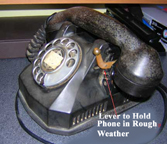
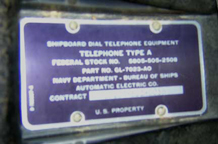
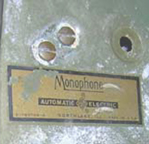
Exterior, Label and Base of the Shipboard Monophone Click to Enlarge
Steve writes:
".... it was salvaged from a WWII Era naval ship, possibly a destroyer. Amazingly it still works after all these years. [I'm] Not sure of the exact year, or what kind of ship it came from. I'm really interested to see if anyone knows anything about the phone. ..."
Another of our readers observes:
"... I have two different models of this phone. One is the desk model as shown the other is the wall mount with the cradle for the handset on top. Both work beatifully and have a nice LOUD ring. I am a ship nut and while cruising through photgraphs of interior shots of the fast battleships of WWII I saw both versions. The wall mount was in the captain's cabin mounted on the bulhead by the door to his quarters and the desk model was on a desk in the gun plot fire control room. I purchsed both from a surplus company 25 years ago. They have never failed to work unlike the modern versions. ..."
Yet another Steve (Steve H.) writes:
"... Automatic Electric manufactured Private Automatic Branch Exchanges (PABX) for shipboard use on many World War II vessels. The switch was a "Step" type with apparatus that stepped down 10 levels and "across" 10 more levels, making a combination of 100 contacts possible. Associated with the switch was a Power Plant furnishing 24 volts to each phone. There was also a rack of batteries for emergency power, a Ringing Plant to signal the phones, and a Ship-To-Shore switchboard for use while the vessel was in port.
The image of a type "A" Monophone shows the "lock-down" handset, necessary in high seas. The dial originally had a numerals-only plastic faceplate with radium painted into the numerals so the phone could be operated in darkness if necessary. The MC-131 ringer was of the same construction as that used in field phones, a single gong with the armature & coils underneath. Most "A" telephones had two reinforced screw holes in the base, to allow the phone to be permanently mounted to a desk or shelf.
Type "A" and all other shipboard phones are compatible with regular telephone wire lines, but the rotary dial pulses may not be recognized by modern digital systems. Converters are available to send touch-tone signals after each digit is dialed. They simply plug into the phone jack, and the phone can be plugged into the converter (assuming a modular cord plug is installed). ...
So, I invite more of our readers to comment further about the shipboard monophone.
Click here to look at another type of collectible, or keep on scrolling for more telephones.
Signal Corps Model TP6A
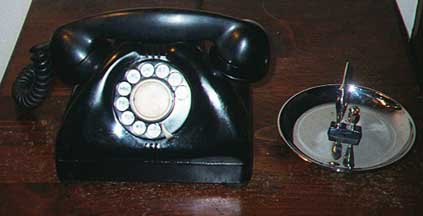
Signal Corps Phone Type TP-6A
The "Soviet Princess"
Click to Enlarge
Not all telephone companies were affiliated with the Bell System. There were a number of independent local phone companies that built and maintained their own equipment, since they did not have access to Western Electric, the manufacturing arm of the Bell System. This is a Type TP-6A manufactured by Connecticut Telephone and Electric Company for the U.S. Army Signal Corps. This phone probably dates to the mid 1940s.
We doubt that this phone is in absolutely original condition because after I cleaned it up, and wired it to the wall, it worked perfectly. It has a curly cord for the headset, which we believe may have been added in the 1940s or 1950s.
The phone has red letters and black numbers inside the dial. We believe that it is from the 1930s because it has the letter "Z" over the figure "0" along with the word "oper" (for the Operator). Note also that phone dials do not contain the letter "Q" --- in films, they used a number like "QUincy-5-1234" to create a fictitious number, much like modern films use numbers like "555- 1234" for the same purpose.
We got this note from a reader:
"... Actually, some vintage US phone dials did have the letter 'Q' on them, with the '1'. I have two like that, but have never found any detailed information about how or when the 'Q' was used with dialing codes or local numbers..."
This phone has a heavy cast aluminum case. The headset appears to be made of wood. It works just fine and has a great ring. Kudos to the Signal Corps!
Above, you'll find a video of the TP6A in action.
One of our readers sent in this observation:
"I would also like to tell you that the Conneticut military phone you picture is also known as the 'Soviet Princess.' I don't know the origin of the nickname, but thought you might like to have that info.
This fellow really KNOWS his telephones! Check out his Website!
Oh yes, sitting next to the phone is a "Penguin Ashtray" from the Chase Art Metal catalogue
Click here to look at another type of collectible, or keep on scrolling for more telephones.
Stromberg-Carlson Model 1243
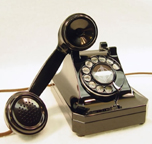
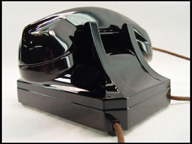
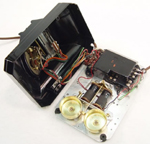
The Stromberg-Carlson Model 1243
Click to Enlarge
This is the Stromberg-Carlson phone that was designed around the WE 300 series. Differences between it and the WE302 are fairly superficial. These are much rarer than the 302.
Click here to look at another type of collectible, or keep on scrolling for more telephones.
Phones and James Dean
I got involved with this phone when a reader sent me the following photograph of James Dean's apartment on 68th Street in New York City. The photo was taken in 1955.
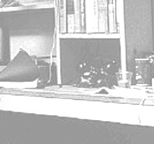
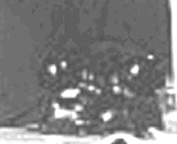
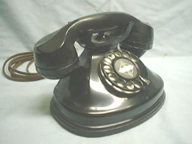
James Dean's 1955 Apartment
... and a closeup of the phone
...the Stromberg-Carlson Model 1212 "Fatboy"
..Or, is it a Kellog Type 925 Masterphone
Click to Enlarge
I think that the picture of Dean's apartment has Stromberg-Carlson Model 1212 telephone. The unique design of the broad-bottom phone with the built-in ringer was a transition between the 1940s Model 302 (see below) with a square base and classic phones of the 1920s that have an oval base. The Model 1212 is known by collectors as the "Fat Boy." The phones of the 1920s did not have a ringer in the desk set (it was in a separate box mounted on the wall). Hence the earlier phones had a very slim footprint. When the ringer was incorporated into the deskset, the apparatus had to grow in size.
Our reader Steve disagrees - with good reason since the photo is quite blurry - and argues that the instrument is a Kellog Type 925 Masterphone.
Either way, the phone was pretty much out of date by 1955, although once Ma Bell installed a phone in your apartment, you were pretty much stuck with it. After World War II, there was an enormous demand for new phone service, particularly single-party numbers. During this period, the Bell System was hard-pressed to keep up with demand. This situation was the basis for the film "Pillow Talk" (Rock Hudson/Doris Day). This phone is consistent with James Dean's status as a "starving young actor" at the time.
If you want James Dean's Phone (or one like it) All you have to do is put "Stromberg-Carlson Model 1212" into a search engine and you'll probably find a phone vendor. This type of telephone needs to be modified somewhat to work on contemporary systems. (Fortunately, all the changes are on the inside...) I would NOT buy one of these from an online auction -- rather, I'd get it from a dealer who warrants that it will work on today's systems. Expect to pay $225-$275 for this model in good working condition. It will only get more valuable with time as they are somewhat prized by Art Deco collectors.
We seem to be a magnet for James Dean photos. Another reader sent in this photo, ostensibly of the office of James Dean's Agent. This puzzled us for quite some time, because the phone appears to be an Automatic Electric Model 80 -- but, you can clearly see that the dial is on a white background.


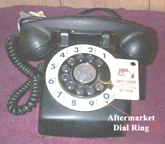
The Phone in James Dean's Agent's Office
... and a closeup of the phone
...the Automatic Electric Model 80 with and aftermarket Dial Ring"
Click to Enlarge
I am going to guess that the Agent has an Automatic Electric Model 80 phone -- and that he had bad eyesight and put on a bigger Dial Ring to see the numbers better. It looks like the phone behind his hand is another AE80 without the after-market dial ring. That's my guess. Here is a photo of the AE80 and another phone (not an AE80) with the after-market dial ring.
You are free to write us if you can positively identify the phone. We are only guessing.

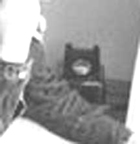

The Phone in James Dean's Parents' House
... and a closeup of the phone
...Possibly a Kellogg 1000, possibly a WE 302"
Click to Enlarge
Thanks to the magic of the internet, we have yet another photo of James Dean and a telephone. In this case, Mr. Dean is shown actually USING the telephone. The setting has been identified as the Indiana home of Mr. Dean's family. Thanks to the miracle of PhotoShop, we can enlarge the photo:
The photo is pretty grainy -- my first impression was that the phone was a standard garden variety black Western Electric Model 302. This is discussed in some detail above. However, our friends at Vintage Swank suggested that this might be one of the famous Kellogg Model 1000 "Redbar" phones (discussed above) because the base is fairly thick and the handset has a distinctive "ridge" along the top
Why is it that Mr. Dean came across no Western Electric phones in his travels?
Click here to look at another type of collectible, or keep on scrolling for more telephones.
The '50s and the 500 Series
About 1946, Bell Labs sponsored a large series of "human factors" experiments aimed at making telephony a more pleasurable experience. One of the findings was that the traditional layout with an opaque dial and letters inside the holes led to a whole lot of mis-dialing. These data were turned over to Henry Dreyfuss, the celebrated industrial designer who came up with the layout that was to become standard -- white raised sans-serif letters molded into the plastic outside a clear plastic dial ring.
By the way, later studies showed that misdialing went down by more than 50% --- which paved the way for the telephone company to move to direct long distance dialing and eventually to all digit phone numbers. We have to agree with Henry Drefuss and Bell Labs --- this phone is a whole lot easier to dial than our Model 302. Here is a little video starring the WE-500
The Western Electric Model 500 telephone became the standard desk-style telephone set used by AT& T (the Bell System) in North America from the late 1949 through the divestiture of AT&T in 1984. Many millions of Model 500 phones were produced and were a familiar sight in almost every home in North America. Numbers of Western Electric 500 phones are still in use today thanks to their durability and ample availability on the secondhand market at inexpensive prices. The basic phone's modular construction not only made manufacture and repair simple, but also made possible a large number of variants and derivatives with added features. Check out this website for a definitive history of the WE500 and all its variants.
Touch-Tone was introduced to home consumers in 1963 with the Western Electric model 1500 telephone, with only the 10 number keys. In 1968 the Western Electric model 2500 telephone was introduced. Similar to the model 1500, the model 2500 added the * and # keys; that model is still in production today by several manufacturers. However, touch-tone is outside the scope of this retro page.
Western Electric Model 500
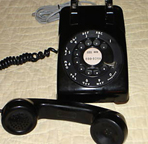



Western Electric Model 500
Desk Phone - Model 500, Design Patent D-153,928
Wall Phone - Model 554, Design Patent D-152,276
Click to Enlarge
A reader sent in this valuable information about the WE-500 series:
"The 500 was the normal desk set found in most homes. This numbering was carried forward when the touch tone phones were introduced by adding a 2. The touch tone desk set became the 2500 and the wall set became the 2554. There were many other types of the 500 series with different features and different numbers. For instance the 501 was configured for party line use. The Phone Store has a terrific site that shows these different feature sets. "
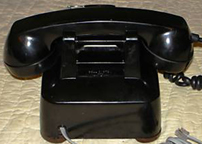
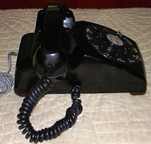
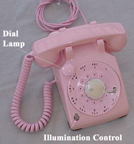
More views of the Western Electric Model 500
.. and one with a Dial Lamp
Click to Enlarge
Click here to look at another type of collectible, or keep on scrolling for more telephones.
"Explosion-Proof" Western Electric Model 520


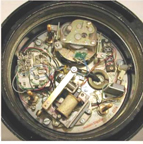

Western Electric Model 520 "Explosion Proof" phone
Click to Enlarge
This is the Western Electric Model 520. It is a single line phone that has a sealed round enclosure that will not give off any sparks, and is, hence, "explosion proof". It weighs about 20 pounds, and was firmly mounted on a wall, usually in places where sparks might be a danger (e.g Natural Gas plants, Refineries, etc.). If you can't read the warning in the photo, here is what the tag says:
CAUTION:TO PREVENT IGNITION OF HAZARDOUS ATOMOSPHERES,
DISCONNECT LINE WIRES AT THE PROTECTOR BEFORE OPENING HOUSING
THE HOUSING MUST BE LOCKED BEFORE THE LINE WIRES ARE RECONNECTED.
Western Electric took elaborate precautions to make sure the works were completely surrounded by lots of cast metal to contain any possible sparks. The base plate and sides seem to be at least 1/2 - 1" thick. The hookswitch connects mechanically through a long plunger rod. The bell vibrates a lever that rotates a shaft that activates a clapper between the gongs outside the sealed area. The dial linkage is also through a shaft. Curiously, the fingerwheel is still on the dial inside the sealed area. The fingerwheel outside rotates a shaft which has a lever and brass "finger" which turns the dial (see top right photo.)
.Western Electric Model 564
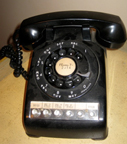

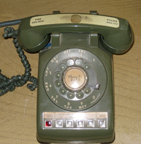
Western Electric Model 564
Multi-Line Desk Set
Click to Enlarge
The Model 564 was a six-button "key set". The buttons controlled four separate lines with both a "hold" feature and an intercom. The far-right button was often labeled "buzz" since depressing it would cause a buzzer to sound on all the phones wired into the circuit. These examples came from a doctor's residence/in-home office that was built in the late 1930s. below, you will see remnants of both the "old" and "new" wiring that was needed to make this possible. Each phone was attached to a cable about an inch in diameter.


Western Electric Model 564 Lead-In and Internal Wiring Required
Multi-Line Desk Set
Click to Enlarge
We got the following note from our reader Jonathan :
"... I just purchased a Black WE 564HL as I have always wanted one. I was lucky enough to get one that is in perfect condition. It even came with the original box (lucky). ... I'm very glad that you have pictures of one with button descriptions. I knew red was hold of course but wasn't sure what the others were used for. Anymore information you have on this phone would be great ..."
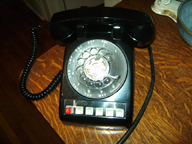
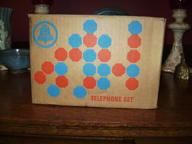
Jon's Western Electric Model 564 and Its Original Box
Multi-Line Desk Set
Click to Enlarge
Click here to look at another type of collectible, or keep on scrolling for more telephones.
Stromberg-Carlson Model 1543
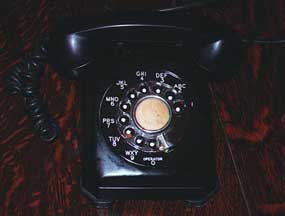
Stromberg Carlson Telephone Model 1444
Click to Enlarge
We found this telephone on Bulk Trash day. This is a Stromberg-Carlson prototype for the Western Electric 500 series, the classic 1950s phones. We believe this dates from the late 1940s. Please note the face --- the letters are outside the dial which itself is made of clear plastic.
This phone is also a curiosity because it looks something like the Model 500, but it is made of hard rubber instead of thermoplastic. Note that it has squared off corners, because rubber could not be moulded into the streamlined curves that characterized the Model 500
Remember --- that trash can on the corner may just be filled with History
Click here to look at another type of collectible, or keep on scrolling for more telephones.
Pay Telephones

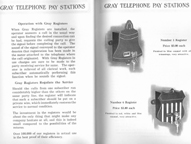
Pay Telephone Station, New York, c.1880
Description of the workings of a post-pay system
Click to Enlarge
Pay telephone stations, available as early as 1878, were supervised by telephone company attendants or agents who collected the money due after people made their calls. Some pay stations utilized a fail-safe collection method: After making the connections for customers, attendants would lock them in booths so they couldn't leave without paying. Systems similar to this may be found in European hotels. As implemented in the mid 1960s, hotel pay stations are an integral part of the plot of the book and film Day of the Jackal.
William Gray is generally credited with the invention of the coin-operated telephone; prior to this, Gray's claim to fame was inventing the inflatable chest protector for baseball. He was not related to Elisha Gray, Bell's competitor for the honor of inventing the telephone. He formed the Gray Telephone Pay Staion Company and in 1889, installed the first public coin telephone in a bank in Hartford, Connecticut. It was a postpay machine (coins were deposited after the call was placed). This had numerous problems, especially with dishonest patrons.
In 1898, the Western Electric No. 5 Coin Collector, the first automatic prepay station, went into use in Chicago. The depositing of coins before placing a call would gradually become the norm in pay phones until the introduction of "dial tone first" service in 1966.
By 1902, there were 81,000 coin-operated telephones in the United States.
In 1910, Western Electric and Gray Telephone Pay Station Co. signed an agreement for Gray to manufacture coin collectors for the Bell System using both Gray and Western Electric patents. The result of that agreement, the 50A coin collector, went into production in 1911. By the end of 1912, 25,000 of these coin telephones had been ordered for New York City alone. The 50A model had three coin slots--for nickels, dimes and quarters --and was a "prepay" machine. After being screened for authenticity, coins would fall down a chute and strike a gong -- with a separate tone for nickels dimes and quarters. The operator would listen to the sounds and when she had heard the right amount of change being deposited, she would place the call. (At the time, all operators were women.) The basic design, though often modified, was so practical and reliable it remained in production until 1964. When I was in college, my engineering friends invented numerous ways to duplicate those tones. My favorite was a music major who could vocalize the tones; at a party, people would shout things like "$2.75" and he would respond with the appropriate sounds. In 1965, Western Electric introduced the 50A's successor. Among other things, it had a single coin slot instead of three, and electronic signalling of coins deposited replaced mechanical bells. Then my friends the electrical engineers got into the act...
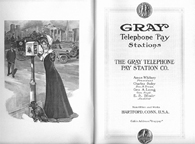
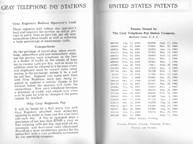
Excerpts From the Gray Telephone Pay Station Co. Catalogue
Click Here to read the whole Gray Catalogue
Click to Enlarge
In 1905, the first outdoor Bell System coin telephone was installed on a Cincinnati street. It wasn't an instant hit; people apparently were reluctant to make private calls on a public thoroughfare.
Bell and Shield Collectors
The collector was an add-on device that could be used to convert an "ordinary" phone into a payphone.
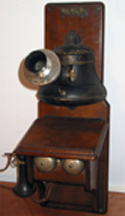
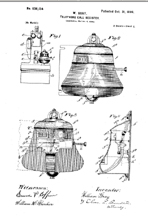
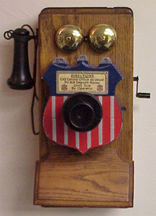

Bell and Shield Collectors
Bell Collector Patent No. 636,134
Shield Collector Patent D - 37,263
Click to Enlarge
This bell-shaped coin collector is mounted on a Western Electric #85 "fiddleback" phone. This particular collector was only distributed through the Bell companies on WE equipment. The independents countered with a Gray specialty collector in the shape of a shield - the symbol for independents. (The collector is shown mounted on a Stromberg Carlson wallphone) The Gray shield collector would only be mounted on non WE wood phones.
The collector body is cast iron and is comprised of three major assemblies. Inside there are lead chutes, one for the nickel and one for the dime. There are two gongs. The dime hits both, the nickel hits only one. Each gong had a different pitch
Gray Model 14 Portable Pay Phone
Gray was the leading manufacturer of pay stations in this era, holding all the key patents, and resold through Western Electric and other companies.
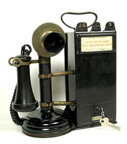


The Gray Model 14 Portable Payphone
Patent no. 985,616
Click to Enlarge
Gray Model 23-D Pay Phone
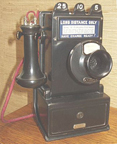
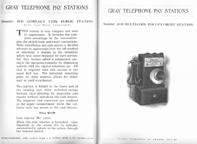

Gray Model 23-D Pay Phone
Patent No. 1,195,234
Click to Enlarge
This is an early post-pay model -- the operator would make the connection for you and then ask you to deposit the coins. The company must have really trusted the customers, because the terminals for the receiver are exposed and vulnerable..
Gray Pay Phone Models 50 - 75
To most of you, the following payphone is eminently recognizable -- and it was introduced in 1912!

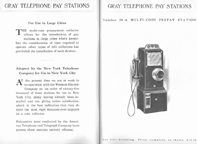

The Gray Model 75 Pay Phone
Not appreciably different from the Model 50 introduced in 1912
Patent No. 1,383,472
Click to Enlarge
This three slot pay station was the precursor of the three slot payphones that were common well into the 1950s and 60s. This phone is a 'pre-pay' model, and has the old-style transmitter and receiver (pre single-piece handset days) and an extra fancy dial that looks like a Mercedes hood ornament. Note that the dial is all that separates it from its 1912 cousin!
Western Electric Model 233 Pay Phone


Western Electric Model 233 Payphone
Patent No. 2,891,112
Click to Enlarge
This is one of the last 3-slot pay telephones made by Western Electric before the development of the single-slot pay phone. The linkage between this 1960s era phone and the 1912 phone is quite evident.
Phone Booths
The booths that house pay phones have undergone more design changes than the phones themselves. At the turn of the century, indoor booths were constructed of durable hardwood, such as mahogany, with comfort and privacy in mind, and exhibited detailed craftsmanship. They were often carpeted. The "original" telephone booth is credited to Thomas Watson, the man who helped Alexander Graham Bell invent the telephone. Watson's 1883 booth was built of expensive wood, had a domed top with a ventilator, windows with screens, and a desk with pen and ink.
Here is a video that shows an old wood phone booth up close and personal.
The telephone booth acquired a reputation as a place of refuge frome the world. It was not unreasonable that Clark Kent should change into Superman in a phone booth.
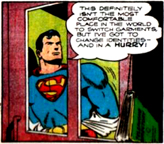

Uses of the Phone Booth (Other Than Communication)
This never happened on the TV show, never
The record is 25 people according to the Guiness Book Click to Enlarge
Over the years, telephone booths have reflected their surroundings as well as the times. There have been phone booths resembling cable cars in San Francisco, and others resembling pagodas in New York City's Chinatown district. In the 1960s, as American architects designed glass-wall office buildings, wooden phone booths looked out of place in lobbies. Bell Laboratories designed an indoor glass and metal phone booth to better fit newer surroundings.
When Bell Laboratories designed a new glass and aluminum outdoor telephone booth in the 1950s, it was a great advancement over the wooden outdoor booths that had been in use for a number of years. And yet several booths ordered by the U.S. National Park Service were found mysteriously broken and battered. Park rangers soon knew the answer, though: It was mating season for moose. Amorous--but territorial--bulls were charging the booths whenever they saw their reflections in the glass. This was the style of phone booth that attracted college students in the 1960s after a LIFE magazine article reported that 10 students had been able to stuff themselves into a phone booth.




The Classic 1940s-1950s Wood Telephone Booth
Patent No. 2,248,810
Click to Enlarge
Here are some advertising cards that would have been placed in the booth. Generally, they encourage use of the Bell System.


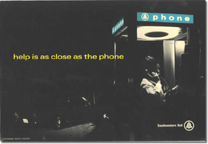
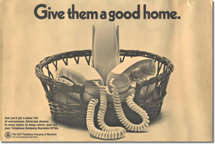
Telephone Booth Advertising Cards
Click to Enlarge
Here is a very sentimental ad that shows old and new styles of phone booths together.

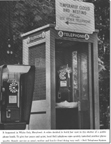
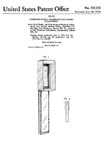
Old and New Public Telephones Together
Left: Old style Patent No. 1,770,612 Right: Kiosk Style Patent D-232,223
Click to Enlarge
When Bell Laboratories designed a new glass and aluminum outdoor telephone booth in the 1950s, it was a great advancement over the wooden outdoor booths that had been in use for a number of years. And yet several booths ordered by the U.S. National Park Service were found mysteriously broken and battered. Park rangers soon knew the answer, though: It was mating season for moose. Amorous--but territorial--bulls were charging the booths whenever they saw their reflections in the glass. This was the style of phone booth that attracted college students in the 1960s after a LIFE magazine article reported that 10 students had been able to stuff themselves into a phone booth.

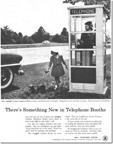

Aluminum and Glass Phone Booth
Patent Nos. 3,341,988 and 2,925,770
Click to Enlarge
Click here to look at another type of collectible, or keep on scrolling for more telephones.
Other Interesting Phones
Western Electric Field Telephone
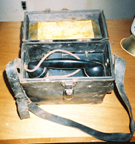


World War II Western Electric Military Field Telephone
Western Electric Patent No. 2,252,751
Click to Enlarge
This is our Field Telephone. It dates from the 1940s and was probably used in World War II
Our Reader Rich, a proud member of the US Marine Corps (OOH-Rah!) has a World War One vintage Field telephone that he would like to learn more about:
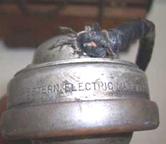

World War I Western Electric Military Field Telephone
Western Electric Patent No. 1,354,908
Click to Enlarge
So, I invite our readers to write to us about the Field Telephone.
Click here to look at another type of collectible, or keep on scrolling for more telephones.
Lineman's Phone

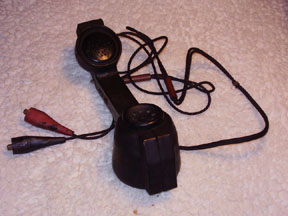
Telephone Lineman's Handset (BECO)
(left) showing Dial
(right) showing Earpiece and Mouthpiece
Click to Enlarge
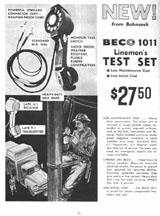
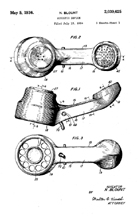

Ad for the BECO Model 1011 Telephone Lineman's Handset
Telephone Lineman's Handset Patent No. 2,039,625
Click to Enlarge
Click Here to find out how to ger FREE Patent Drawings
Above is an ad from BECO extolling the virtues of the Model 1011
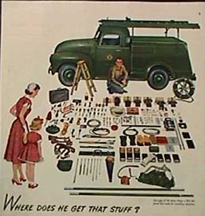
Bell System Ad Showing the Lineman's Equipment
Click to Enlarge
Here is a video that shows the various activities that a typical telephone repairman would engage in during the day. You can see a BECO set in use, hanging off the repairman's left side on his butt in the opening footage.
Click here to look at another type of collectible, or keep on scrolling for more telephones.
Where can I get my phone fixed?
After some research into the history of our WE 302 phone and a considerable amount of probing into its innards (where we learned exactly how well it was made...), we concluded that the dial mechanism was damaged beyond our ability to repair it.
We did not fret or worry, because we simply typed "Repair Antique Telephones" into the Yahoo! search engine on the home page of our site. This put us into contact with several vendors of old phones and repair services. After sending some e- mails, we found that The Phone Vault in Seattle had the best prices and wrote back the most charming letter.
From: The Phone Vault
Hello!
We don't feel confident giving wiring advice on telephones
through the mail, phone or email. Our primary reason for
this is that through the years, many of these units have
been worked on, and pieces and parts switched or replaced
and it is very difficult to give a correct answer to a
specific problem.
Many of these phones have harmonic ringers that were used in the days of party lines. These ringers won't work on most of today's telco systems. We usually replace them with a straight line ringer that is compatible with today's systems. Another problem you could be having is a polarity problem.
Our labor for restoring the older phones is $25 plus parts and return shipping. If we need to work on the dial, there is an additional $25 labor charge.
Please make sure that you insure the phone with whatever carrier (USPS, etc.) you choose. They are heavy, and we've seen a few of them damaged in shipment to us. Pack it really well!
Shipping information:
PhoneVault.com
P.O. Box 770
Ocean Park, WA 98640
Other Stuff:
- Insurance Value: We sell the 302's for between $120-$150 depending on base and condition.
- Payment: You can pay us either by personal check or by Visa/MasterCard. We usually don't accept payment until the work on the phone is finished.
- Line Cord: Depending on the year your phone was manufactured, the rubber line cord could be the original. We can replace it with a cloth cord (brown or black), but we prefer to leave as much of the original phone in tact as he possibly can. Your choice, though.
- Modern Compatibility: Yes, when you get your critter back home, it will be ready to plug into a modern modular (RJ11) jack.
- Ringer: The old ringer's usability will depend on whether it is one of the harmonic ringers I mentioned before. If we have to replace the ringer, we try to find one with a similar sound.
- Dial Card: Sure, we can come up with the dial card for you. When you send us the phone, please note that on your letter to us... and what phone number you would like on the card.
Thanks for stopping by our site. I checked yours, and it is
great. I bet that keeps you busy.
Sheri Stritof
Roy's Phones
We shipped our little phone to Roy's on November 9 and we had it back on December 20 --- there were about eight days of shipping involved. The total cost, including two-way shipping was $70. The phone is a thing of beauty and when it rings, it evokes the 1940s, especially Pennsylvania 6-5000 Best of all, the folks at Roy's found us an authentic dial card for the old C&P phone company and prepared it with our correct "exchange format" number --- WOodley 6-1691. We were happy to have our little phone back for Christmas --- he tells us that he had a great time talking about the good old days with his pals in Roy's shop
Click here to look at another type of collectible.
Counter for the Entire Site (not just this page..)
Home | About Lindy | 1940s Collectibles | Upcoming Events | vintage clothes
The Guide - Establishments - Travel - Accessories
Music | Links | Photo Gallery | Extras | Contact